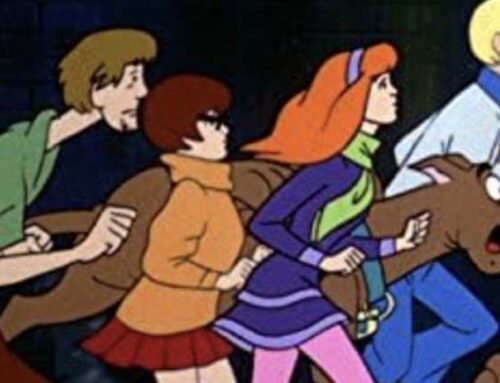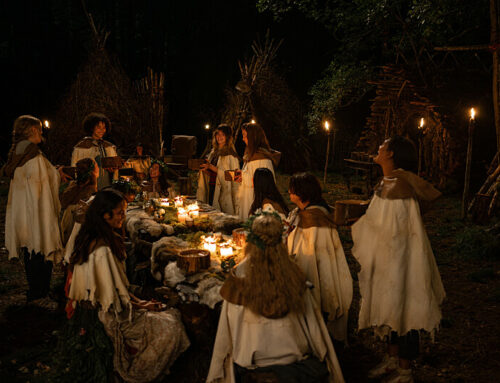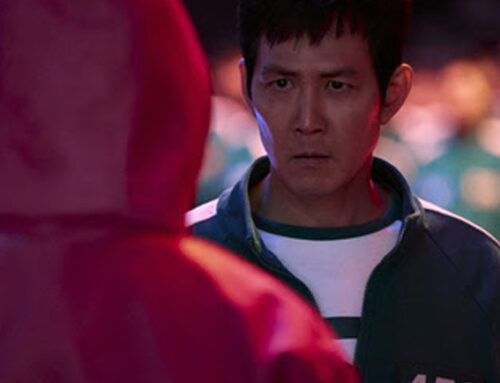As the cultural influence and mainstream popularity of Latinx horror icons Guillermo del Toro and Robert Rodriguez continues to grow, many horror fans, especially Latino horror fans, are curious about the roots of Latinx horror, especially in the United States and Latin America. Wanting to explore the diversity of Latinx horror, dedicated horror fans and childhood friends turned co-host Jonathan “Jonny” Atkinson and Aileen Clark, created the Latinx horror podcast ¡Uy Que Horror!.
With over 100 episodes ¡Uy Que Horror! is dedicated to deeply exploring Latinx horror films both American and international. They bring to the attention of the English-speaking audience the films of Latinx horror filmmakers, on-screen Latinx talent in horror films, and cultural stories and folklore.
Atkinson and Clark share with us the films that ignited their love for horror, their inspiration for creating the podcast, and what lesser-known Latinx horror films people should know.
Bonilla: How did you become a fan of horror films?
Atkinson: I’ve been a fan since I was a little kid. I have various memories of being affected by horror. The first memory was when I was living in Brazil. My mom sat me down and she told me, “We’re gonna watch Jaws.” Five minutes in, at the beginning when that poor woman gets eaten by the shark, five-year-old Jonny shouted, “Stop! Turn this off!” That was horrifying! It was very impactful and still scares me to this day.
I also remembered we had family movie nights when I was a child. My parents picked An American Werewolf in London, which totally scared me. Not the werewolf, but Jack, the friend who gets killed and haunts David throughout the movie. I hated that.
Eventually, I built a kind of fascination, where as much as I was scared and wanted to turn away, I also kept wanting to look. It started with Gremlins and Arachnophobia. I call them gateway horror.
I started watching the Nightmare on Elm Street movies. Honestly, I think the Nightmare on Elm Street films, the further they go along are horrors for children. I know that’s wrong to say, but there so colorful and imaginative. Freddy Kruger specifically becomes less dangerous and more just entertaining as the films go on. I believe as soon as that happened at a very young age, I was hooked. I haven’t looked back. I love horror. It’s my favorite genre.

Clark: I’m different. Growing up, horror was not for me. I was truly terrified of it. When Jonny and I met in high school, he tried so hard to shove horror movies down my throat. I loathed every minute of it. I had nightmares all the time.
I have this visceral memory of being young and living in Brazil. They would play commercials for movies on TV. I remember seeing the commercial for Child’s Play and would show clips of the film. The little section when Chucky’s face distorts and he’s coming for the mom scarred me for life.
I like to think that the way I started tiptoeing into horror, was when I was in Maryland visiting Jonny from San Francisco when we were in college. I was staying over at his parent’s house. Jonny had something to do and wasn’t at home. I was in his bedroom, watching movies on TV.
The Shining came on, and I thought to myself, “You know what, I’m gonna give it a go”. I remember watching it when Jonny’s mom came in and asked me, “What are you watching?” I said, “The Shinning”. She nervously replied, “Well, okay. Buenas Suerte (good luck).” Then she left me to watch it on my own.
When I officially was ready to accept horror as my Lord and Savior, was about six, maybe seven years ago. It was October and I told myself, “I’m going to try and watch as many horror movies as I can this month.” I sat there by myself and I watched Halloween, Alien, Hellraiser, and The Thing. After that, I felt ready to not be terrified.
Then the pandemic hit. The week where we were all shut down, I told myself, “I’ve never seen it. I’m gonna watch Night of the Living Dead”. I watched it by myself. Then I was officially in.
How did you two meet?
Clark: I love telling this story. Jonny and I lived in Brazil, at the same time, for different reasons. My dad was working as a metallurgist and Jonny’s dad was working in banking.
I changed schools at one point and went to the American School of Brasilia. There, I met a guy named Chris Atkinson, who is Jonny’s older brother and in my grade. I remember going to a birthday party and seeing Jonny running around doing this thing.
After one year of the Atkinson family being in my life, they moved to Bolivia, and I stayed in Brazil. Eventually, I moved to Nicaragua. One day, in the second semester of 11th grade, there was a new kid in class. The teacher introduced him, “This is Christopher Atkinson.” It was Jonny’s brother! Chris came before Jonny.
Once I started senior year, Jonny came. Chris and I had this friendship that fizzled out in a high school way. One day, I called the Atkinson house, trying to talk to Chris and Jonny answered the phone. Two hours later, that was it. Since then, we’re best friends. I love to think it’s fate, because how can people that met randomly in Brasilia, Brazil, then move on to meet in Nicaragua?
When did you become interested in Latinx horror?
Clark: During the pandemic, Jonny, his now husband Matthew, and I had a little movie club, where we were alternating between watching action and horror movie franchises. It was a particularly bleak time in everybody’s life. You’re just trying to live your life day by day.
I was watching these horror movies and I wondered, “Where are the Latinos?” There are so many movie franchises that have ten different movies in them, with maybe one Latino that goes by every now and then. It’s very rare if they are the lead. It’s not seeing the representation and knowing that it’s out there.
I thought, “There’s got to be more than just Guillermo del Toro”. More than just Mexico. There’s no way that from south of Mexico, down to the tip of Chile and Argentina, there isn’t gonna be horror there. I sent Jonny a text message, asking him, “What if we did a podcast, focused on Latino horror movies?” God bless Jonny because he agreed.
How did you develop the title?
Atkinson: I made a list. Originally, the top of my list was ¡Uy Que Horror!. I thought, “It’s catchy. It’s funny”. I remember I also had on my list ¡Uy Que Miedo!. So, pretty early on ¡Uy Que Horror! fit for us.
Clark: Horror in Spanish and English is written the same way. Even for English-speaking listeners, you can see ¡Uy Que horror!, and then you’ll understand that it’s horror base.
Atkinson: It’s more accessible. We want Latinx and non-Latinx people to listen to this and realize this whole world exists. If you’re a horror lover, you should be watching this. The word horror specifically, gets more eyes on this.
How do you decide on the films to feature?
Clark: We have a criteria that every now and then we bend. Our movies have to be made in a Latin American country, come from a Latin American country, have a Latin American director, have a Latin American lead, if the storyline or the main plot is focused on Latin America, and/or a mixture of all of that.
For example, we just covered X. Three of the leads are Latino, Mia Goth, Kid Cudi, and Jenna Ortega. Even though it’s an American film, we featured X. The whole point is to highlight the Latinx experience, the Latinx people, their stories, and where they come from. So many of the Latinx films that we cover are collaborations, with Italy, Spain, or England. There’s also going to be the Latinx experience through the American lens.
Atkinson: I don’t think most audiences would look at X and that this has Latin American roots. That’s something important for us. This movie that came out this year was a huge hit and people loved it. X has not just one, but three people who have Latin American roots. It’s important to highlight this.
And shout out to Aileen. When we started doing this podcast, she compiled a huge list of movies from all the Latin American countries. This just goes to show that these movies are out there. You just have to look. There’s still so much more out there, if you’re willing to reading a subtitle or two, every now and then.

What have been some of your favorite films to cover on your podcast?
Clark: I’m particularly fond of the sentimental horror movies that we have covered, like Good Manners. It made me sob. I also love the fantasy vibe of horror movies, like Tigers Are Not Afraid. That was another one that knocked my socks off. X was so fun. A movie that genuinely freaked me out was Aterrados (Terrified). Also La Casa Muda (The Silent House). I was voguing in fear watching that movie.
Atkinson: Some that stuck out for me recently are La Región Salvaje (The Untamed) from Mexico. I loved that movie. And Piedra, Papel y Tijera (Rock, Paper, Scissors) from Argentina was good.
The movie Al Morir la Matinée (The Last Matinee) is by this great director Maximiliano Contenti from Uruguay. It’s a great slasher movie. The villain in the movie is played by Ricardo Islas. Islas is a very well-known director from Uruguay. He directed this werewolf movie called Plenilunio. It’s a handheld camera, super low-budget movie, but the most incredibly charming and entertaining low-budget movie I’ve seen in a long time. Aileen and I both loved it.
Clark: Plenilunio has this Goonies vibe, with little kids like figuring out a mystery, but also solid gore for a low-budget movie. I think werewolf movies often don’t get the credit they deserve.
What would be some films you would like to eventually cover?
Clark: When Jonny and I first started working on the podcast, we recorded a test episode, just to see how it would go and what the flow would be like. We’ve never released it. I would like to do Pan’s Labyrinth because that was our test OG episode, but not release the test recording. I want to record it for real.
I would love to do IT. We covered the short of Mama, by Barbera and Andrés Muschietti. I had a huge problem with clowns when I was growing up. I remember watching IT and thinking, “This is dope!”
Atkinson: I’m excited to get back to Carlos Enrique Taboada. We’ve done two Taboada films, Hasta el Viento Tiene Miedo (Even the Wind is Afraid) and Veneno Para las Hadas (Poison for the Fairies). These movies are so good. We just want to eat these movies with a spoon. There’s so delectable. I’m very excited to get back to him.
I would love to get back to Robert Rodriguez films and do The Faculty. Aileen has never seen it and I’ve seen it a million times. I love The Faculty so much. I’m very excited to cover The Faculty.
Why is it important for you to bring attention to Latinx horror?
Atkinson: First of all, one of the things for me to do with this podcast, was to reconnect with my Latinx roots. I live in the States now, which tons of Latin American people here. But being here in the States makes me feel a little bit far from the way I grew up. I want to reconnect to that and make my Spanish stronger. I just want to know more.
The Latinx market is huge for horror. They’re one of the strongest demographics that support and go to see horror. Then we should be more prevalent in these films. We should be featured more. But why not?
This year has been such a wonderful year for Latinx horror. Talking earlier about X, people don’t know that Latin American people are not only featured but are also the stars of these movies.
Clark: Another reason to do the podcast is to verify history. K. Gordon Murray is this horrible guy, who basically took all these Latin American movies, brought them to the US, put them out there, and welcome the money into his pockets. He didn’t give the credit where it’s due. Murray screwed us over. So, in a way in our tiny, small way, we’re giving the credit where the credit is due.
How unique is Latinx horror storytelling?
Clark: I think people take for granted the storytelling in Latin American horror. Very often, especially non-American based movies from Latin American countries, are folklore based, or the stories that abuelitas (Grandmothers) tell you as a cautionary tale. These directors have used these creepy creatures and stories that you’ve been told about before bed like Cucuy and La Llorona. There’s something so wonderful in using this oral tradition of telling stories in film that are meant to keep you safe and make sure that you’re aware of your surroundings. Horror is a great vehicle for that.
There’s so much rich storytelling within the Latin American version of fear. Those monsters and creatures are fun to put in different modern-day situations. Let’s see where they originated from. We’ve learned about El Sibón, El Tunche, and all these monsters that live in these countries. Very often we find similarities between them, which is really cool.
Diving into those types of movies and that type of storytelling is so important for keeping the culture alive. It’s a smart way to bring it into the modern world. It’s a great way to show the culture, the folklore, and to show the different types of storytelling that our countries have to offer. Their beautiful, terrifying, and more eyes need to be on them. Because at the end of the day, you’ll learn something, be entertained, and still be spooked enough to have to check under your bed at night.

For readers not familiar with Latinx horror, what are some films you would recommend as an intro to Latinx horror?
Atkinson: I would throw in Coffin Joe. He was hugely influential, not only in Brazil but in all of Latin America. They called him “The Freddy Kruger of Brazil”. He was Tales from the Crypt before that even existed. He was so original. José Mojica Marins came up with that. That character drives us crazy, but it’s magical.
Also, the films of Carlos Enrique Taboada. He’s very important. As Aileen said, “So decadent, so beautiful”. El Esqueleto de la Señora Morales (Skeleton of Mr. Morales) directed by Rogelio A. Gonzales, is so good. It’s a classic. I would throw in Al Morir la Matinée (The Last Matinee). That one, I just loved it.
Clark: I would say if we’re going super old school definitely see the Spanish language Dracula. Because it’s a fun evening to watch the Spanish and English versions to see how almost identical they are, with their tiny differences.
I’d also say Alucarda, which is a great example of a Mexican English-language horror film. It’s hilarious to me that I didn’t know until we made this podcast that there are so many Mexican English-language movies out there. Movies like The Bees and Don’t Panic. Alucarda is so decadent, gay, demonic, bloody and a perfect 1970s encapsulation of what that vibe was, even though it was set in the past.
For folklore horror, La Llorona from Guatemala is not only gorgeous, but an amazing way to portray a country’s trauma, and how the government has affected the people, through this folklore story. It’s brilliant.
Wekufe from Chile. Based on the folklore creature Wekufe, Wekufe is a found footage-style film. We’ve discovered through the podcast that Chile’s horror movies are very trauma-based. There is a movie named Trauma that’s traumatizing. Because they lived under this dictatorship for so long, a lot of their horror is based on the horror they lived with. Wekufe is a good found footage, if you’re into that and if you’re also into discovering stories of the country.
Don’t Panic is a great look at Mexico in the 1980s. It’s a great Nightmare on elm Street sister film. It was directed by Rubén Galindo, Jr, who’s a huge director in Mexican horror. Satánico Pandemonium is a good one too.
When do you release new episodes?
Clark: Our episodes come out on Mondays. We let everybody know the Friday before what movies we’re covering, so they have the weekend to check out the movie. On our socials, you’ll find the movie that we are covering. We also have a link tree that has the entire catalog there for people to check out.
¡UY Que Horror! is available on Spotify, Apple Podcast, and Sonoro.
https://open.spotify.com/show/09yrpSk8KLrO6Y5unQ4gmS
https://podcasts.apple.com/us/podcast/uy-que-horror-a-latinx-horror-movie-podcast/id1534223164
https://sonoromedia.com/uy-que-horror
Social Media:
https://twitter.com/Uy_Que_Horror
One Comment
Comments are closed.








[…] Justina Bonilla Source link […]